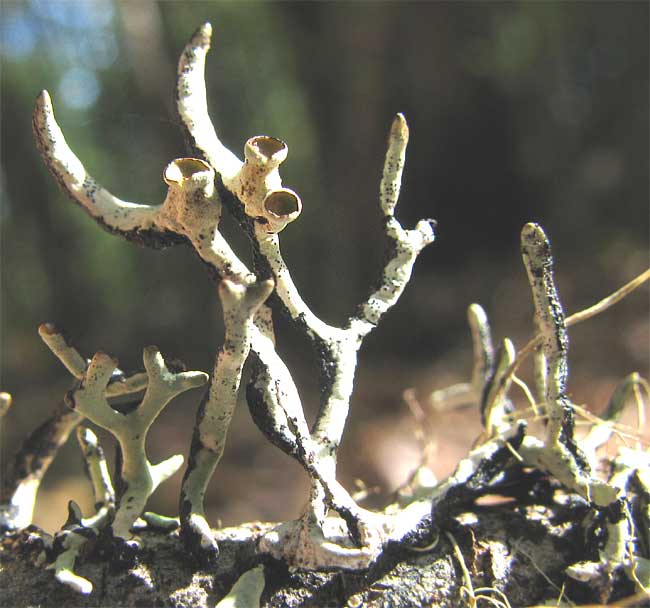Excerpts from Jim Conrad's
Naturalist Newsletter

from the September 13, 2009 Newsletter, issued from the Siskiyou Mountains west of Grants Pass, Oregon:
FORKED TUBE LICHEN
Around here any small, dead, brittle twig falling from a tree will likely be covered with lichens, for during the long rainy season the humidity here is very high, just as lichens like. One of the most common lichen species, though too small to be much noticed, is shown above.
This is the Forked Tube Lichen, HYPOGYMNIA IMSHAUGII, or a species near it. Experts haven't decided yet whether there's just one very variable species or a cluster of separate similar species.
Usually one to two inches long here, they're called tube lichens because their stem, or thalli (singular thallus), are hollow. They so habitually grow on twigs and bark that the species is regarded as epiphytic. The Forked Tube Lichen's most visible field marks are its forked or "dichotomous" branching, its stems being white on one side and black on the other, and the plant often bearing those little cuplike things on the two branches pointing toward the picture's top, left. The cuplike things are reproductive structures called apothecia. Since a lichen is a combination of a fungus and an alga species growing together, the apothecium's similarity to some mushrooms isn't coincidental; the lichen's fungal part produces the apothecium.
So, fungal spores are produced by microscopic, baglike affairs (asci) covering the apothecium's inner concave surface. The spores germinate where they find a perfect environment, send out a wandering fungal strand that eventually finds cells of the right alga species, and starts growing around them. As both fungal and algal cells multiply and enmesh, the lichen takes form. The lichen also produces asexually with conidia or conidiospores, which can be thought of as more or less like dust particles coming off the fungus, thus producing new lichens with the same genetic makeup as the parent.
Forked Tube Lichens are limited to North America's western coastal mountain ranges and the northern Rockies.